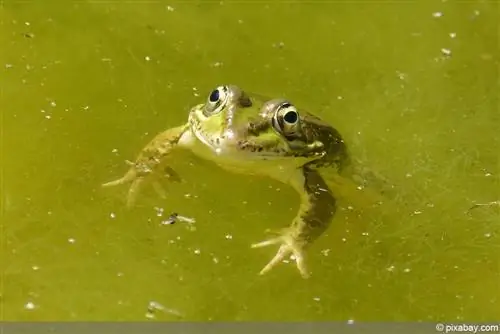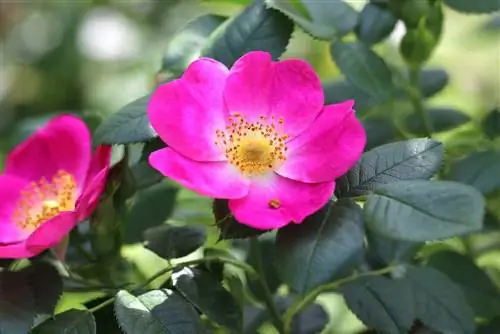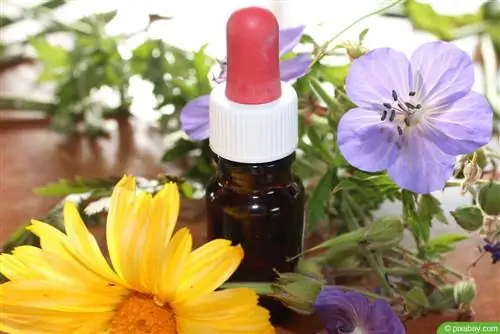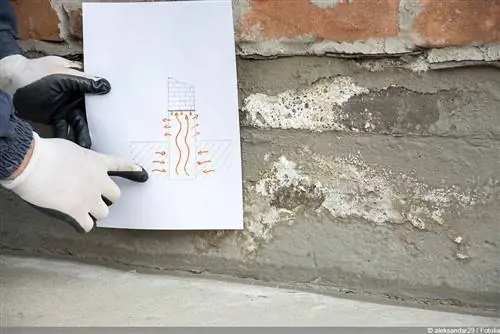- Author admin [email protected].
- Public 2023-12-17 03:39.
- Last modified 2025-06-01 06:48.
Algae can settle almost anywhere. They only become a problem when the water in the pool shimmers green or the house facade shines green instead of white. In addition to green algae, there are other algae that can spoil the bathing experience in the pond or pool. Algicides fight algae or prevent them.
Basic
Algicides are biocides and therefore chemical agents that are intended to eliminate or prevent harmful organisms. Because they have similarities to crop protection products, they are also known as non-agricultural pesticides. In addition to algae killers for pools, there are also active ingredients for other areas of application. Algae can grow in many places. They are also unsightly on garden paths, on house facades or roofs.
Note:
Biocides should always be used with caution and only in emergencies. There are no chemical agents that are completely harmless and harmless to the environment.
Active ingredient groups
- Simazin - no longer approved in the European Union, toxic to fish, not dangerous to bees
- Atrazine - Use prohibited in the EU, dangerous especially for aquatic organisms
- Desmetryn - outdated pesticide active ingredient
- Dichlorophen - broad spectrum of action, no longer approved as an algaecide
- DCMU - no longer permitted in Germany
- Copper sulfate - previously used against algae in swimming pools
- Copper oxide chloride - mainly used as a fungicide
- Benzalkonium chloride - the most commonly used active ingredient today
- Pelargonic acid - also used in lubricants
- Cybutryn - old biocidal product, was suitable as an underwater paint against algae
- Terbutryn - Algicide in emulsion paint
Algicides with preventative effects

Some algicides are used purely for prevention. They are intended to prevent the formation of various types of algae. For this purpose, they are regularly added to the pool water, for example. Or they are mixed with facade paint or the facade is painted with a ready-made algicide mixture. In the case of products with a preventive effect, other active ingredients are sometimes used, such as algae killers.
Areas of application
Algicides with a preventative effect can be used wherever the formation of algae is to be avoided. These include pools, facades or terraces. It is more difficult to use it in ponds or swimming pools. Almost all algicides are not suitable for use in ponds because they can harm aquatic organisms. And that too in the long term. Use in the pond can lead to the biological balance being disturbed. Not only is the algae prevented from growing, but also other aquatic plants. In addition, an algaecide can kill sensitive aquatic organisms.
Application
Most algaecides are easy to use. When used in the pool, add the product to the water according to the instructions on the package. Regular use is important. If an agent is to protect the facade from algae growth, it is either mixed into the facade paint or underneath orpainted on the paint. Ready-mixed algicide solutions are available for purchase for this application. These can be sprayed, rolled or painted depending on your preference.
Precautionary measures
Algicides are not harmless, most are poisonous and/or have a corrosive effect. Appropriate protective measures should be taken when handling.
The following applies to work on the facade:
- Cover the floor around the work area
- Wear gloves and protective work clothing
- possibly safety glasses
- Keep children and pets away from the work area
- Do not spill the product or allow it to enter the groundwater
- Do not dispose of leftovers in household waste
Applies to pools:
- Dose medium carefully
- Please pay attention to the instructions on the package
- filter water before swimming
- If skin irritation occurs while swimming, leave the pool immediately and shower off
- take special care with children
Tip:
Other measures should be taken in the pond to prevent algae. The same applies to swimming ponds.
Algicides that destroy algae
Algae should be completely removed. The products also have a preventive effect against renewed algae infestation. Some active ingredients prevent algae from forming spores. However, it is more effective if as much algae as possible is removed before use.
Areas of application

Algae killers are used in algae-filled pools, on garden paths and on facades. They are used when a preventive effect is no longer sufficient. Even if a heavily algae pond makes you feel the need to use an algae killer, you should avoid it. Since a swimming pond relies on biological purification through aquatic plants, no algae killers may be used if the plants are not to be affected.
Application
Before using the chosen algaecide, as much algae as possible is removed mechanically. Pool walls in particular should be scrubbed vigorously. The same applies to garden paths or facades. A high-pressure cleaner can also be used here. The algicide is then applied according to the instructions. Pool water must then be filtered to remove the algae from the water.
Precautionary measures
When using algae killers, it is even more important to observe the appropriate protective measures.
- Protect hands and eyes
- keep out of reach of children and pets
- do not swallow
- do not allow it to reach the groundwater






